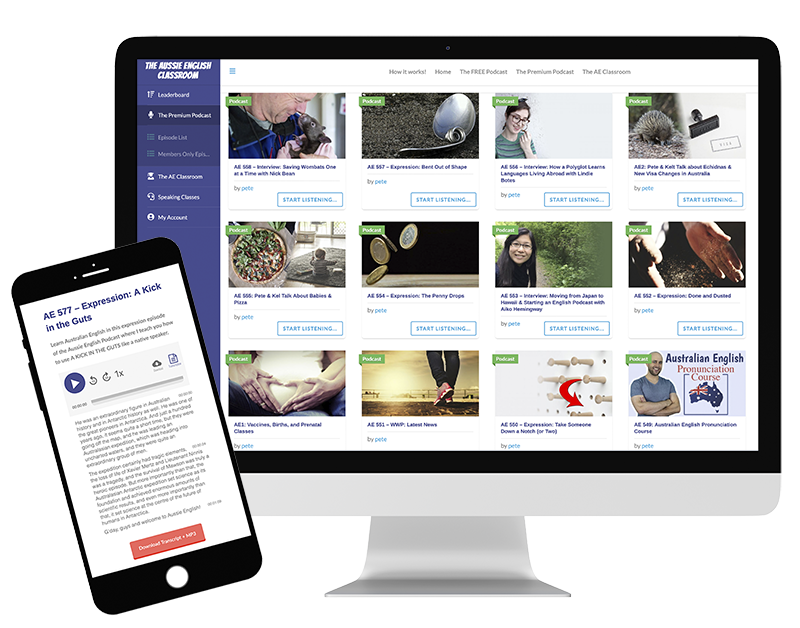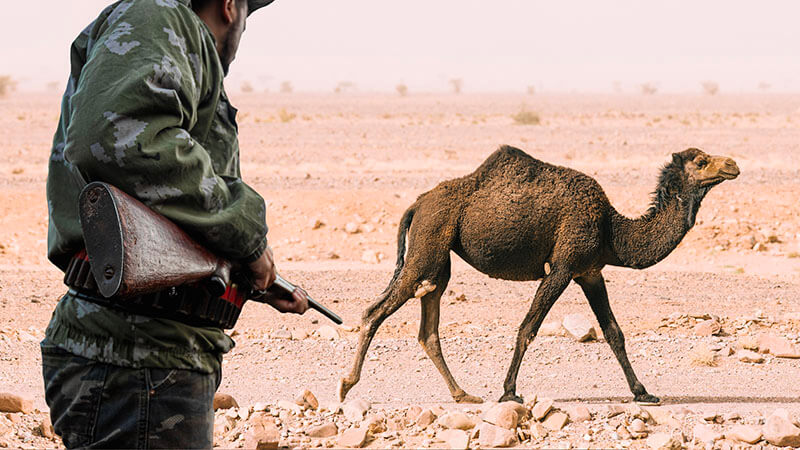AE 466 – Ship or Sheep? | English Pronunciation of /i:/ vs /ɪ/
Learn Australian English pronunciation in this episode of the Aussie English Podcast where I teach you how to pronounce the vowel sounds /i:/ vs /ɪ/ in words like ship or sheep.
AE 466 – Ship or Sheep? | English Pronunciation of /i:/ vs /ɪ/
I’ve just crept up on these kangaroos here and I’m about maybe 10m away from them.
Today’s video is for anyone who has ever said “shit” instead of “sheet” or “bitch” instead of “beach”.
Let’s check it out.
G’day, guys. My name is Pete and today I want to teach you the difference between the vowels /i:/ and /ɪ/.
So, every since I started teaching English I’ve had a lot of people ask me, “How do I pronounce the difference between the vowels /i:/ and /ɪ/ as in the words “sheep” and “ship”?”.
And hopefully after today’s video you’ll be talking about taking that shitty sheet to that bitch of a beach like a native speaker.
These two vowel sounds seem to be the trickiest for ESL learners to differentiate between in English, and I am yet to meet someone who speaks their native language that includes both of these vowel sounds.
So, if you speak a language where both of these vowel sounds are used, make sure you let me know below which language that is. I’m really curious.
All right, so let’s tackle why you’re having trouble with these vowel sounds, and we’ll start by looking at the IPA vowel chart.
Don’t freak out! We’re not going to get too bogged down in the details of phonetics, okay, but I need to show you this to help you understand a little bit of what’s going on.
So, in order to understand how vowels are made in the mouth we have the IPA vowel chart, guys, and that is this weird looking trapezoid shape, which is made, or it’s meant to represent the shape of the mouth, okay?
So, horizontally when you look at this chart you’ll have the front of the mouth versus the back of the mouth horizontally.
Whereas, vertically, you’re going to have the closed mouth right at the top, closed, the jaw is right up, versus the open mouth right at the bottom, okay?
So, if you were to swallow this chart it would fit in your mouth, like this image shows you, and it will show you the placement of your tongue in order to make these vowel sounds in English, okay?
And I’ll show you the corners of this vowel chart just to give you and idea.
All right, so closed and front /i/. Closed and back /u/. Open and front /a/. Open and back /ɑ/. So, that’s the basic idea, okay?
Now I want to show you, in this picture, where these two vowel sounds, /i:/ and /ɪ/ are found in the mouth, and you’ll see they’re very close together, in fact, they’re almost overlapping, they’re that close together.
So, what you’re going to have here is effectively closed front vowel sounds. So, they’re at the front of the mouth. You need that tongue right at the front of the mouth, and the mouth is somewhat closed. It’s most closed for /i:/, and it’s slightly open for /ɪ/. Okay? We’ll get into that shortly.
Anyway, so that is the reason you’re finding these vowels hard to say. They’re very close together, okay? They’re very close together.
But now let’s go over the slight differences of how to pronounce these vowels.
All right, so the vowel sound /i:/. Say it with me. /i:/. This is a closed front vowel sound. So, the mouth is closed, the tongue is close to the top of the mouth and the front of the mouth. It is a tense vowel sound so you are tensing the muscles in in your face a little more than the other vowel, which we will go over shortly, which is relaxed. But /i:/ is tense, so you’re smiling, you’re pulling the lips sideways, /i:/, the tongue is coming forward, forward in the mouth, and nearly touching the palette of the mouth, the roof of the mouth. These is about 1mm, about the thickness of this spoon, between your tongue here and the roof of your mouth. /i:/, /i:/. You should also feel the teeth on either side of your mouth above, just above, the tongue, touching it though. /i:/, /i:/.
A trick to know if you’re doing this right is that you should feel some vibration between the top of your mouth and the tongue. /i:/. You should feel it on both surfaces, okay, which you won’t feel with /ɪ/.
The /i:/ vowel sound is also a long vowel sound. It is elongated, guys. /i:/. Whereas, the other vowel /ɪ/ is very short. /ɪ/. It is not elongated. Sheep, not “shep”, sheep.
All right. So, why have I got this spoon? The trick to making sound, guys, because there is only 1mm between your tongue and the palette, you should be able to put a spoon shaped like this above your tongue and push it against the palette and still make this sound. So, watch this. /i:/, /i:/. But if I try and say /ɪ/, the other vowel sound, /ɪ/, this should drop out, /i:/, /ɪ/, /ɪ/, because now there’s more space, more than 1mm, and I can’t hold the spoon in place. So, this is a trick for seeing if you’re saying it correctly. /i:/, /ɪ/.
All right, guys, now let’s go over the vowel sound /ɪ/ as in the word “ship”. So, say it with me, /ɪ/, /ɪ/. So, this is a relaxed vowel sound so the face isn’t as tense. You don’t need to smile as intensely. You can have a looser face. /ɪ/. It’s a shorter vowel sound, so it’s not elongated. You just say a quick /ɪ/, /ɪ/, /ɪ/ sound, okay?
Although it is a closed front vowel sound as well, like /i:/, it is slightly more open, okay? So, instead of having only 1mm between your tongue and the palette, this time you’re going to have about a finger’s width, about a finger’s width, about 1cm, between your tongue and the roof of your mouth.
And so you can check this by putting your finger in your mouth instead of a spoon this time, and you should be able to still say the sound even though that finger is sitting between your tongue and the roof of your mouth. Watch this. /ɪ/, /ɪ/. And my tongue was only lightly touching my finger so there is quite a bit of space there.
All right, guys. So, hopefully, that helps. Hopefully, that gives you some tricks on how to practice this vowel sound. Remember, try and find a spoon, something very thin, that you can put in your mouth and say /i:/, and if it falls out, your mouth is too wide, you need to close your mouth a little bit more and say that sound.
Whereas, if you want to say the sound /ɪ/, you should be able to use your finger, /ɪ/, /ɪ/, /ɪ/, and still be able to make that vowel sound. Whereas, you can’t make the vowel sound /i:/ with your finger in your mouth. /i:/, /i:/. It doesn’t sound the same. You’ll notice that your tongue is pushing your finger too much to the roof of your mouth, /i:/, /i:/, and it doesn’t work.
So, now let’s go through some minimal pairs, guys, and then a couple of sentences using these minimal pairs, okay? So, listen and repeat after me, guys, and practice your pronunciation. Let’s go.
Shit – Sheet.
Bitch – Beach.
It – Eat.
Fit – Feet.
Chip – Cheap.
Itch – Each.
Sit – Seat.
Did – Deed.
He should eat it.
This chip was cheap.
This sheet is shit.
She is itching each itch.
Did he do the deed she did?
Do your feet fit in your shoes?
The kid needs to sit in his seat.
It’s a bitch getting to this beach.
Awesome job, guys. Awesome job. I hope now that it isn’t a total bitch saying words like beach and that you don’t feel shit saying words like sheet.
Before we end, I want to let you know that I have a course specifically designed to teach you Australian English pronunciation.
So, you can sign up to this for just $1 for your first 30 days. The link is in the description. And I take you through how to make all the different sounds in Australian English. All of the different vowel sounds, all of the consonants, and I give you videos, and MP3s, and exercises. I give you minimal pairs comparing similar sounding words that differ with that sound, and then I give you a whole list of tongue twisters designed specifically to help you perfect each of these sounds. Anyway, guys, give that a go if your goal is to improve your Australian English pronunciation.
Thanks for sticking with me for today’s episode. Don’t forget to subscribe, guys, and I’ll see you in the next video. Peace!
I’ve just crept up on these kangaroos here and I’m about maybe 10 m away from them and they’re all eating. I’ve been sitting here for a while now and they’ve just chilled out. Every time I talk they kind of look up and prick their ears up. It’s really cool though because they’ve got their heads down and they’re ignoring me now, and for me to be this close is really cool.
One thing that you’re going to see is that there is only one really big kangaroo in this mob and that’s the dominant male, which you’ll see in the centre right here.
Here's what you get when you sign up!
- Read while you listen using the Premium Podcast player.
- Understand every word in every episode.
- Download all PDF transcripts and MP3s for 600+ episodes.
- Get access to bonus member-only episodes.












Responses